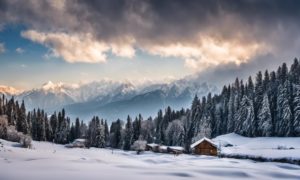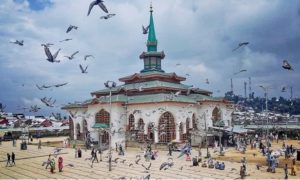A tapasvin into the world came I,
A Bodha illuminated my path to Self.
Lal Ded, also known as Lalleswari Devi or Lalla Arifa is considered the founding mother of Kashmiri literature. Born in a Kashmiri Hindu family in a village a few miles from Srinagar, she was married at the age of 12 into a family that was reported to have mistreated her.
After becoming a disciple of Sidh Srikanth, she renounced her material life and become a devotee of The God. She wandered naked, reciting her proverbs and quatrain-based poems also known as ‘vatsun’ or ‘vaakh’.
During the later parts of her life she came under the influence of Muslim missionaries from Central Asia and the influence can easily be felt in the exceptionally syncretic poetic turn that her sayings took after coming in contact with the principles Islamic universalhood.
Her poetry has been translated widely, including English translations by Richard Carnac Temple in Life and Teachings of Lalla, Jane Hirshfield in Women in Praise of the Sacred: 43 Centuries of Spiritual Poetry by Women (1994), Coleman Barks in Naked Song: Lalla (1992), and K.C.I.E. Sir George Grierson in Lalla-Vakyani or The Wise Sayings of Lal-Ded, A Mystic Poetess of Ancient Kashmir (1920).
However, despite wide acclaim of her work and activism in last few decades, her life had remained lost in the pages of history for a long; a question that must draw an intricate academic atomisation.
The court historian Jonaraja (1459) brought Kalhana’s Rajtarangini down to Sultan Zain-ul-Abideen’s reign, he mentions the patron saint of Kashmiris, ‘Nund Rishsi’, but does not mention Lal Ded. Srivara in his Jaina Rajtarangini chronicles events from 1459 to 1486 C.E, Prajyabhatta in his Rajavalipataka covers the period from 1486 to 1513; and his pupil Shuka describes his master’s work in1586, but none of them utter a single word about Lalla, the spiritual grandmother of Kashmiri culture. She is kept out of the history books by the ‘Chroniclers of the Kings’.
The reasons of excluding Lal Ded by the Brahman chroniclers seems rather strange and needs an in depth analysis. From what we have of her life, the reasons could be three: it could be assumed that all these Pandit ‘Historians’ were Chroniclers of States and Kingdoms, and their scope was limited as far as the record of common events was concerned. Otherwise, some hundred years before, why would Pandit Kalhan not choose to mention the rise of Trika School of Saivism or any of its preceptor philosophers like Abhinawgupta.
But was the life of Lalla really a ‘common event’, or a simple rise of a new philosophy or was it a profound socio-religo-politico catalyst of a greater change that was transpiring around in a milieu simmering under the constant tension and conflict of caste/class based differences.
Could such a catalyst have been ignored by the ‘historians’ of the day, unless wilfully?
The answer isn’t so simple and it lies in the next two possible reasons for such a historical nonchalance to the one who was going to become the grandmother (Ded) of the generations of Kashmiris to come.
Lalla wrote and spoke in Kashmiri. She appealed to the poor and downtrodden peasants in the language they could understand and relate to, a language which was considered ‘Aprabhamsa’, non-literary, inferior and largely inconsequential, by the elite historians.
Her audience consisted farmers, potters, shepherds, a class of people not having any bearing on the working of state. Sanskrit had been in vogue until the advent of Shahmiris and after that Persian became the court language and the language of the literati. The poor kept themselves aloof from the both. They did not appeal the chroniclers. Their traditions hardly found mentions in the great histories of Kashmir, if at all as passing comments.
This was the reason, Lalla, who spoke in the “vulgar tongue of the unlettered masses” was not found worthy of mention by the chroniclers in their annals.
However, the lore of Lalla, though not part of the ‘Great histories’, continued to be an integral part of discourse and conversation back then and continues to thrive until this date, unlike Sanskrit and Persian, which are almost non-existent in common imagination and folklore.
The last and the most plausible reason for the Pandit chroniclers’ disinclination to give Lalla a place in their books was that she had thrown all conventional respectability of a caste based community to winds and was considered a renegade by the high caste Brahmans.
She was vehemently critical of orthodoxy, its dogmas and rituals, its hypocrisy and exclusiveness, it division and particularism. She came from a Brahmin family herself but was highly critical of ceremonial pieties of religion as is seen in her vaakh:
O fool, right action does not lie,
In fasting and other ceremonial rites.
She was disliked for her purposeful indifference to conventional social norms of the day: caste, food and drink (anas khyenas kyah chhum dvesh).
I renounced fraud, untruth, deceit,
I taught my self to see truth in all my fellow men.
How I then discriminate between man and man,
And not accept the food offered to me by brother man.
She was not simply “unmindful of caste taboos” as is claimed by numerous students of history but presented the earliest opposition to caste based hierarchical social order, very well aware of the success of her role, actually making her the first anti-caste activist in history of world.
Whatever I uttered with my tongue,
Became a mantra.
Many of her ‘vaakhs’ are rife with tirades against the proponents of the prevalent order based on ‘superiority by birth’. She believed that only work, kindness and compassion towards fellow beings can make one superior; everything else being corruption of the elite.
No word, silence, dynasty, or ‘low birth’ is there,
Even silent gesture finds no entry,
Shiva and Shakti too vanish,
What abides is the ‘One’, that is the hint.
It may be pointed out that Lalla was disowned, not only in her own times but for a greater part of Kashmir history, by the elite on account of her hostility to the Caste superiority. There have been admirable attempts by some recent elite scholars to claim Lalla in their works, however deceitful deconstruction into a historical vacuum of a mystic who was isolated from the realities her time as opposed to a sincere and honest reconstruction of her legend must be clearly shunned off.
Her life drew vitality from the struggle created in the individual psyche by the manifold abuses of caste oriented social order is fact as stark as her belief in Siva.
Lalla’s poetry does not give any proof of her embracing Islam but there are evidences of her close associations with Saiyad Hussain Simnani and many other Muslim preachers. She came in constant contact with the Muslims from central Asia and their metaphysics of universal brotherhood, as is pointed out by Richard Carnac Temple in his book on life and teachings of Lalla, he says: “The more or less uncertain accounts of these Muslim teachers have been dwelt on to some extent because of their obvious importance to the story of Lallá, since Lallas date can be approximately fixed by her association with them as at the end of the fourteenth century of the Christian era; and because in all the circumstances there can be no difficulty in accepting the tradition of Lallá’s connection with the Muhammadan holy men of mark in Kashmir in her time”
Lalla’s poetry created micro-culture which drew its essential vitality from a conflict, a division, a torment and struggle created in individual psyche by the challenges posed to the social order by Lalla’s and Sufi missionaries universalism. Her writing are immanent with a tussle against religious ethnocentrism and asserting rights of the underprivileged through universal egalitarianism.
This is also evident in the reverence that is held by the Muslim historians and chroniclers. In-fact the first recorded mention of Lal Ded is in the hagiographical document of Baba Dawud Miskati in his Asrar-ul-Abrar written in 1654 C.E.
She is compared with the Muslim Saint Rabia, and is often referred to as Rabia Sani (The second Rabia). She is also called Lalla Arifa. In the third volume of his chronicle, Per Ghulam Hassan writes: “The saintly lady ‘Arifa, a mystic of highest order was a second Rabia”.
Haji Mahu-ud-din corroborates Tarikh-i-Hassan in his Tarikh-i-Kabir and calls her, “second Rabia of Basra”. Some other early chroniclers that mention her by name are Muhammad Azam Dedmari (1746 C.E) and Abdul Wahab Sheikh (1754-62).
Nuruddin Reshi accepted her as his spiritual preceptor and drew inspiration from his poems. Consequently, the poems of the two mystics gave a spiritual Weltanschauung to the illiterate masses and became vehicle for the dissemination of Islamic ideals of equality and brotherhood.
While Lalla’s conversion to Islam is a matter of an academic/historical discussion, what is established is that her works were largely preserved either in the ballads of the poverty stricken lower class Hindu and Muslim peasants, in songs of Muslim minstrels, or through works of Muslim Rishis who venerated her as a revered sage in their own writings or tried to model some of their verses on her mystical experiences .
Yes, there were subtle or sometimes substantial variations of her words, however, the intensity of her spiritual experience and authenticity of her poetic expression were largely preserved in their words. They kept Lalla’s thought and poetry alive in history.
The memory of an otherwise forgotten ‘Ded’ (Grandmother) of Kashmir was preserved through Muslim folklore and popular culture. Lives of saints and sages are shrouded in some myth, some miracles and some legends. We need to be acquainted with them in a way in which the pious of their followers have clothed them; something of magic, something of miracle and something of the poetry of faith, however, without losing the track of the truth.
Khawar Khan Achakzai is a published author, a medical Doctor by profession, and a student of history.
Views and opinions expressed in this article are those of the author’s and do not necessarily reflect the editorial position and policy of Free Press Kashmir. Feedback and counter-views are welcome at [email protected].












